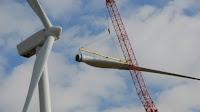 For some people a pedal-powered commute make sense. This technology is evolving along with speed and comfort.
For some people a pedal-powered commute make sense. This technology is evolving along with speed and comfort.Alternative Energy News.info reports:
"Based upon high tech aerodynamics engineering and standard cycling technology, Goblin Motors introduces products that offer a reasonable way to commute using human power alone. Drivers have protection from the elements, whether it is hot or cold, sunny or raining. Popular in Europe for years, this is the first time that such vehicles have been designed and manufactured to accommodate larger American citizens.
Visit the Goblin Aero page for project details and photos. Look forward to the release of Goblin Motors’ new hybrid drive power assist on Earth Day, 2009." See full article.






